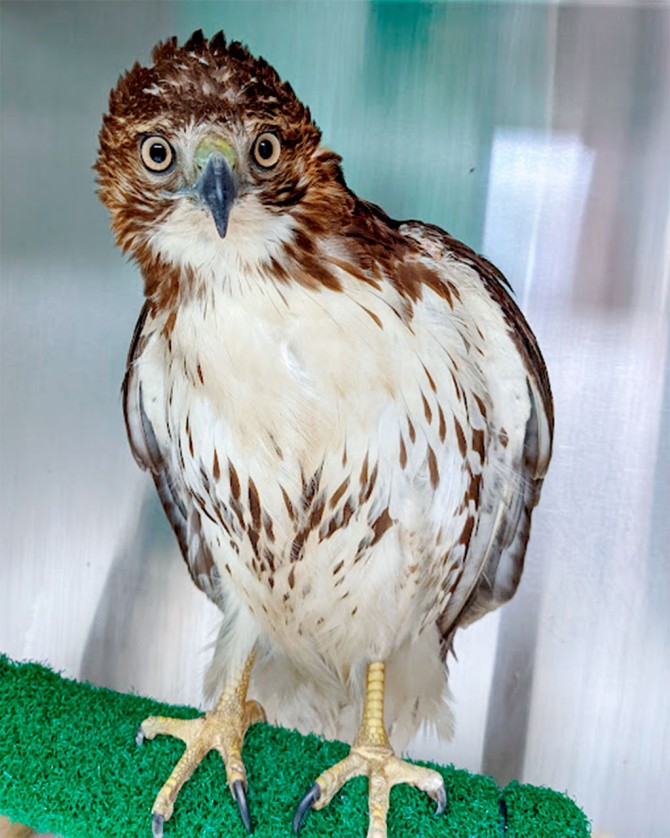Rodenticide poisoning widespread among NY’s red-tailed hawks
By Lauren Cahoon Roberts
Birds of prey in the empire state are in trouble, according to a recent study by clinical researchers at Cornell University College of Veterinary Medicine.
The paper, published May 12 in Ecotoxicology, details how 68% of red-tailed hawks have anticoagulant rodenticide (AR) toxins in their systems, indicating that poisoning of this kind is widespread among New York state raptors.
“It was a surprise to see how pervasive this problem is,” said Dr. Cynthia Hopf-Dennis, clinical assistant professor at the Janet L. Swanson Wildlife Hospital and first author on the study. “It’s much more prevalent than I would have ever thought.”
AR toxins are bad news for wildlife. By blocking the availability of vitamin K, they disrupt the body’s ability to clot blood. At high doses, this causes uncontrolled bleeding, shock and death, while lower doses cause lethargy and overall poor health. The toxins can remain in animals’ systems for more than 100 days, so poisoned rodents that do not die immediately are more likely to be eaten by raptors, such as red-tailed hawks, passing the poison to them.
Understanding the true impacts of these poisonings on wild raptors has proved difficult, as scientists do not have regular access to the animals. However, Hopf-Dennis and her colleagues at Cornell were able to study 23 healthy red-tailed hawks from local rehabilitators and outreach programs, and 49 free-ranging red-tailed hawks that came to the hospital as patients. All of the birds came from across New York state, and most of them already had rodenticide in their system.
“This is important for New York raptors,” Hopf-Dennis said. “Rodenticide toxicity is widespread in wildlife in neighboring states like Massachusetts, but recent documentation in birds of prey in our area is lacking and is higher than expected, given recent regulations on second-generation rodenticides.”
While anticoagulation rodenticides are regulated by the Environmental Protection Agency (EPA) and sales to consumers have been halted, “they may still be sold at some stores, or people have a backlog of them in their basement,” Hopf-Dennis said. “People are still somehow using them.”
To treat AR poisoning, veterinarians supplement patients with vitamin K. Given the amount of time the poison lingers in the body, the treatment often lasts for several months as the toxin works its way out of the patient’s system.
With a treatment that requires months of captivity for a wild animal, clinicians want to be sure they have the correct diagnosis before proceeding. However, clinical symptoms of sub-lethal rodenticide poisoning can be vague – lethargy, lack of appetite and dullness are signs of many other conditions, too. Thus, as part of her research, Hopf-Dennis and her colleagues hope to validate a new diagnostic test for AR toxicity in birds that could easily be used in the clinic.
“Right now, a dog or cat could walk into a hospital and easily be tested for AR exposure,” Hopf-Dennis said. “But we still don’t have an effective clinical test for avian patients.”
While she had hoped that a test known as Russell’s viper venom time (RVVT) might be effective as an in-clinic diagnostic, it did not prove effective.
“It’s back to the drawing board for now,” Hopf-Dennis said.
In the meantime, she hopes people heed the EPA regulations and avoid using anticoagulant rodenticides.
“Our wildlife is already facing so many threats – from habitat destruction, to parasites, to disease and car strikes – if we can avoid adding one more human-driven cause to their challenges, we should,” Hopf-Dennis said.
Lauren Cahoon Roberts is director of communications for the College of Veterinary Medicine.
Media Contact
Get Cornell news delivered right to your inbox.
Subscribe


